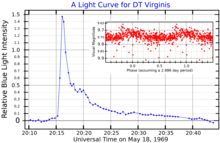A request that this article title be changed to Ross 458 is under discussion. Please do not move this article until the discussion is closed. |
 Image of DT Virginis with the legacy surveys. The companion is the red object marked with an crosshair in the lower right. | |
| Observation data Epoch J2000 Equinox J2000 | |
|---|---|
| Constellation | Virgo |
| Right ascension | 13h 00m 46.557s[1] |
| Declination | +12° 22′ 32.677″[1] |
| Apparent magnitude (V) | 9.79[2] |
| Characteristics | |
| Evolutionary stage | Main sequence |
| Spectral type | M0.5 + M7.0[3] |
| U−B color index | 1.12[2] |
| B−V color index | 1.44[2] |
| Astrometry | |
| Radial velocity (Rv) | −12.33±0.32[1] km/s |
| Proper motion (μ) | RA: −628.7±0.184 mas/yr[1] Dec.: −33.5±0.133 mas/yr[1] |
| Parallax (π) | 86.9010 ± 0.1170 mas[1] |
| Distance | 37.53 ± 0.05 ly (11.51 ± 0.02 pc) |
| Orbit[4] | |
| Period (P) | 13.63±0.03 yr |
| Semi-major axis (a) | 4.93±0.01 AU |
| Eccentricity (e) | 0.245±0.001 |
| Inclination (i) | 130.3±0.3° |
| Longitude of the node (Ω) | 56.25±0.17° |
| Periastron epoch (T) | 2007.67±0.02 |
| Argument of periastron (ω) (secondary) | 157.5±0.6° |
| Details | |
| Primary (A) | |
| Mass | 0.553±0.007[4] M☉ |
| Radius | 0.473±0.021 R☉[5] 0.368±0.031[6] R☉ |
| Luminosity | 0.044+0.016 −0.012[6] L☉ |
| Temperature | 3,484±50[5] K |
| Metallicity [Fe/H] | 0.09±0.10[6] dex |
| Rotation | 2.89 d[7] |
| Rotational velocity (v sin i) | 9.6±0.9[8] km/s |
| Age | 400–800[3] Myr |
| Secondary (B) | |
| Mass | 88.918+1.836 −2.844[9] MJup |
| C | |
| Mass | 11.7+3.6 −3[10] MJup |
| Radius | 1.1±0.05[10] RJup |
| Luminosity | 2.51×10−6[10] L☉ |
| Surface gravity (log g) | 4.38+0.16 −0.17[10] cgs |
| Temperature | 682+16 −17[10] K |
| Other designations | |
| Database references | |
| SIMBAD | data |
| ARICNS | data |
DT Virginis, also known as Ross 458, is a binary star system in the constellation of Virgo. It has an apparent visual magnitude of 9.79[2] and is located at a distance of 37.6 light-years from the Sun. Both of the stars are low-mass red dwarfs with at least one of them being a flare star. This binary system has a circumbinary sub-stellar companion.

This star was mentioned as a suspected variable by M. Petit in 1957.[14] In 1960, O. J. Eggen classified it as a member of the Hyades moving group based on the system's space motion;[15] it is now considered a likely member of the Carina Near Moving Group.[5] Two flares were reported from this star in 1969 by N. I. Shakhovskaya, confirming it as a flare star.[12] It was identified as an astrometric binary in 1994 by W. D. Heintz, who found a period of 14.5 years.[4] The pair were resolved using adaptive optics in 1999.[4] Early mass estimates placed the companion near the substellar limit, and it was initially proposed as a brown dwarf[16] but is now considered late-type red dwarf.[3]
The primary member, component A, is an M-type main-sequence star with a stellar classification of M0.5.[3] It is young, magnetically very active star with a high rate of rotation[16] and strong Hα emission.[3] The star experiences star spots that cover 10–15% of the surface[2] It is smaller and less massive than the Sun. The star is radiating just 4.4%[6] of the luminosity of the Sun from its photosphere at an effective temperature of 3,484 K.[5]
- ^ a b c d e Cite error: The named reference
Gaia DR3was invoked but never defined (see the help page). - ^ a b c d e Cite error: The named reference
Alekseev_Bondarwas invoked but never defined (see the help page). - ^ a b c d e Cite error: The named reference
Manjavacas_et_al_2019was invoked but never defined (see the help page). - ^ a b c d Cite error: The named reference
Laugier_et_al_2019was invoked but never defined (see the help page). - ^ a b c d Cite error: The named reference
Houdebine2010was invoked but never defined (see the help page). - ^ a b c d Cite error: The named reference
Khata_et_al_2020was invoked but never defined (see the help page). - ^ Cite error: The named reference
Küker_et_al_2018was invoked but never defined (see the help page). - ^ Cite error: The named reference
Fouqué_et_al_2018was invoked but never defined (see the help page). - ^ Feng, Fabo; Butler, R. Paul; et al. (August 2022). "3D Selection of 167 Substellar Companions to Nearby Stars". The Astrophysical Journal Supplement Series. 262 (21): 21. arXiv:2208.12720. Bibcode:2022ApJS..262...21F. doi:10.3847/1538-4365/ac7e57. S2CID 251864022.
- ^ a b c d e Cite error: The named reference
Zhang2021was invoked but never defined (see the help page). - ^ Cite error: The named reference
Simbadwas invoked but never defined (see the help page). - ^ a b Cite error: The named reference
Shakhovskaya1969was invoked but never defined (see the help page). - ^ Cite error: The named reference
Kiragawas invoked but never defined (see the help page). - ^ Cite error: The named reference
Petit1957was invoked but never defined (see the help page). - ^ Cite error: The named reference
Eggen1960was invoked but never defined (see the help page). - ^ a b Cite error: The named reference
Beuzit_et_al_2004was invoked but never defined (see the help page).